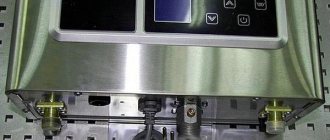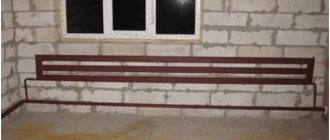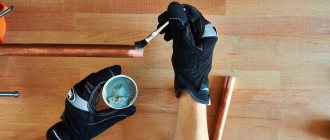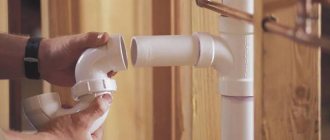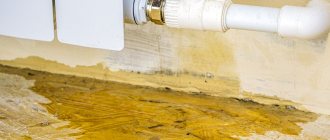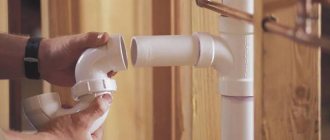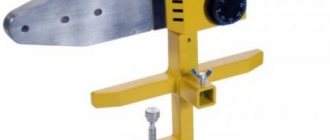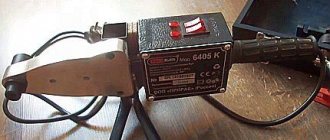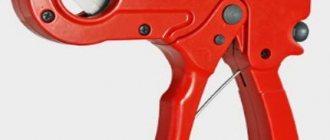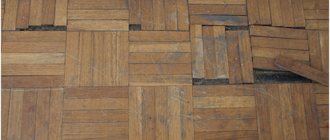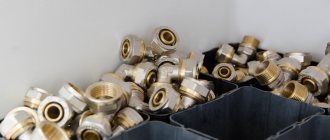In the material about polypropylene pipes, I briefly explained what these pipes are.
Now let's talk a little about soldering these pipes.
It is correct, of course, to say: “welding” or even “diffusion welding of pipes”, but we usually use simpler words: Dictionary diffusion welding, we call soldering Welding machine, we call it a soldering iron or even an iron Polypropylene we call “polycom” or “PPR”
We call the colors this way: White - Turk. (Although Valtek also makes white and the quality of the pipes is at a high level) Gray - Czech Green - German
Soldering
The average temperature of the welding machine should be set to 260 degrees.
Of course, for each diameter there are more subtle temperature settings and on expensive machines, the required temperature is inserted automatically if you specify the diameter of the pipe being welded.
We set the temperature to 260 degrees, put on the desired nozzle, and now all we have to do is remember the time during which we need to heat the pipe.
16th heat for 5 seconds. after which it must be fixed for 6-7 seconds so that the soldering is of high quality.
We heat the 20th for 5 seconds.
25th - 7 sec.
32nd - 8 sec.
40th - 12 sec.
Now more details.
We take the pipe with the coupling in our hands and try to connect them without heating. If this is possible, then there will not be a high-quality connection, replace the components and, if possible, use connectors from the same manufacturer in the same system.
After we have found out that you hold in your hands what you need and can be soldered, we first put the fitting on the nozzle of the welding machine (it is thicker) and then the pipe.
But this is a book example and it is very difficult to attach a fitting and a pipe separately to a soldering iron. Push in at the same time, but you can take out the pipe first, and then the connector.
This is what the heated fittings look like:
Now they need to be connected.
When heating, it is important to insert the pipe completely into the nozzle. To be sure, before soldering, you can make a mark on the pipe how long the pipe should go into the nozzle.
When heating, the elements cannot be twisted on a soldering iron . Although the manufacturer prohibits turns, I still do it, but the turns are very small, I would even say they are some kind of movements to make it easier to put on the pipe with the fitting. It happens that the corner fits very tightly onto the nozzle. This often happens with large diameters, for example 40 mm. In this case, the soldering iron can be moved back and forth a couple of degrees relative to the parts.
If you twist the parts or the soldering iron more than about 5 degrees, then parts of the plastic will remain on the nozzle which will then smoke, and the soldering may be of poor quality. So, if possible, it is better not to turn, and especially not to twist or turn .
After installing the elements completely, we begin the countdown at 5 seconds in the case of a 20 mm pipe. or 8 seconds in the case of the 32nd pipe.
After this time, we first remove the pipe, and then the fitting.
Quickly, but without fuss, we connect these two elements. After connection, you still have a couple of seconds to correct the alignment. After 2-3 seconds. Alignment adjustment must be stopped. Otherwise, the joint will leak.
After the joint, allow the product to cool for about 20 seconds, fixing the joint firmly.
If you are soldering the first joints, then strictly observe the heating and fixation time. In subsequent joints, take into account drafts and ambient temperature. If you are working in a draft and the temperature, for example, is below +10, then the heating time should be slightly increased by 1-3 seconds. depending on diameter. Otherwise, you risk not having time to dock the heated elements, or there is not a second left to correct the alignment.
How to choose a high-quality polypropylene pipe
If you decide to install plumbing or heating with polypropylene pipes, then an important step is the right choice. When you know masters, it is better to ask them for advice on what is best to choose and where to buy.
You might be interested in the article “Installing a toilet with your own hands: step-by-step connection instructions” Go>>
Or explore the available product range on the manufacturer’s website. When purchasing in a store, pay attention to the color, company name, logo, and location of the markings. If you find a discrepancy, then it is a fake.
Pipes and fittings have smooth surfaces. There are no swells or depressions. The wall thickness should be the same.
Do not buy fittings and polypropylene pipes from different companies!
Last stage: cooling and checking the tightness of the connection
Polymer pipes must cool in a natural environment. A forced decrease in the temperature of the material will lead to disruption of a number of processes in the structure of the material. First of all, the strength of the joint will be reduced. To check the tightness the following methods are used:
- perform purging;
- let water through.
INTERESTING: Adjusting water heated floors
Then the permeability of communications is assessed. When a gap appears, water droplets will appear on the outside of the pipeline.
Top best manufacturers of pp systems
Here is a rating of manufacturers of polypropylene systems 2021, compiled according to reviews of specialists. In their opinion, these products are the best in quality and reliability.
Russian trademarks.
Foreign brands.
Necessary equipment
The technology for welding polypropylene pipes involves the use of a specific set of tools. It includes:
- a welding unit with nozzles (soldering iron), operating in manual, semi-automatic or automatic mode;
- scissors for cutting polypropylene;
- ruler;
- knife;
- file;
- degreasing solution;
- rags;
- roulette;
- corner;
- marker;
- shaver, if welding of reinforced polypropylene pipes is carried out.
Basic equipment for soldering PP pipes
The soldering iron is purchased at a specialized store, but in order to save money, you can make it yourself at home. To do this, you will need an unnecessary iron, the sole of which will serve as the basis of the soldering machine. Attachments are installed on the sole, with the help of which it is possible to work with materials of various diameters. The diameter of the nozzles in cases where polypropylene pipes are welded with your own hands ranges from 14 to 62 mm.
Theory of plastic welding
Basically, when welding PPR plastics, the combination of plasticized layers of the product over the joint occurs by applying pressure to form a joint of the material. Processes occurring during soldering:
- adsorption;
- diffusion;
- viscoelasticity and creep.
Main factors affecting soldering:
- welding temperature;
- welding force;
- welding time.
All three sizes are typical for any thermoplastic being welded and must be within strictly defined acceptable ranges. Even if only one of these three factors falls outside these tolerances, the quality of the weld cannot be guaranteed.
Soldering iron option for “advanced users”
An important characteristic of any soldering iron is its operating temperature. Simple models do not have a clear temperature regime, and sometimes because of this it is not possible to do the job efficiently. For example, if the heating is insufficient, the solder will not melt to the required state and will not be able to fill all the necessary gaps. In this case, the so-called “cold soldering” will result, and the connection will be fragile.
In addition, if you have to deal with different options for work, it makes sense to purchase several soldering irons at once, with different powers.
But you can do it easier - buy a soldering station.
Microprocessor controlled digital soldering station Weller WDD 161V works with compressed air or inert gas
The first signs of a pipeline leak
In most cases, leaks in utility lines are immediately noticeable. After all, puddles appear on the floor and other structural elements of the building. However, minor leaks are not always so obvious.
Heating pipe is leaking
If the leak is small, it can be determined by the following signs:
- PP pipes become wet;
- drops that look like dew appear in the area of the fittings;
- the pressure in the pipeline system drops sharply.
If any of the above situations occurs, the owner of an apartment or house needs to pay attention to the water supply network. Perhaps it's time for a renovation.
A leak that is not eliminated, even in the form of a small trickle of water, will cause irreparable harm. Moisture can get on electrical appliances, penetrate electrical cables, or ruin just-completed renovations for neighbors on lower floors.
